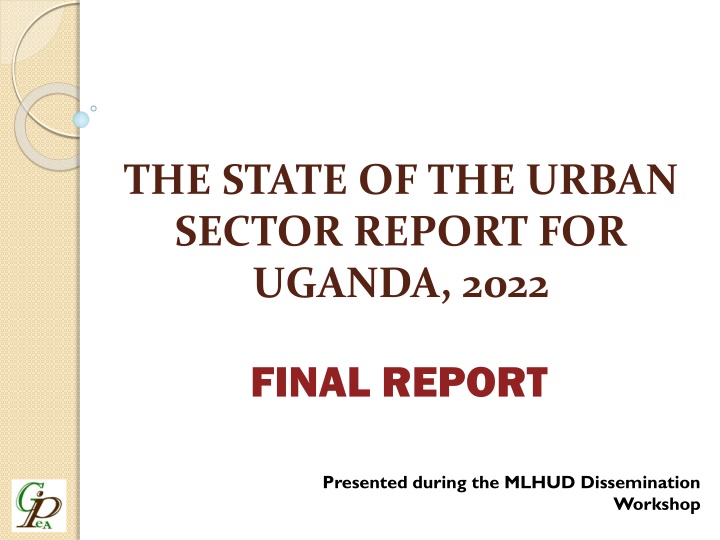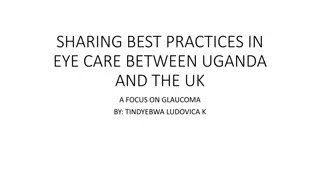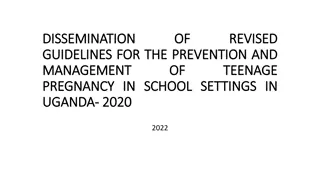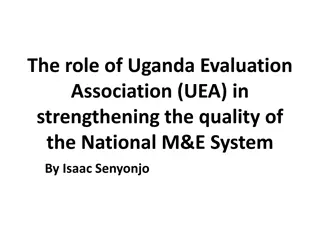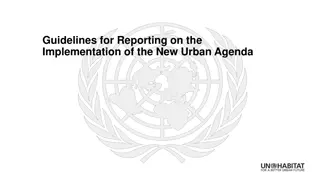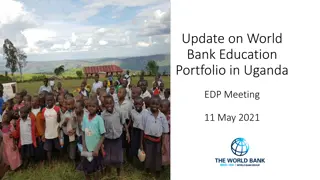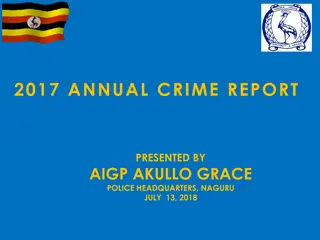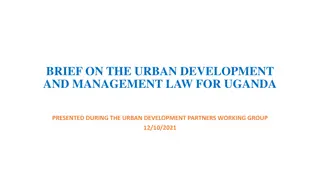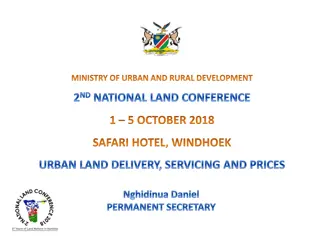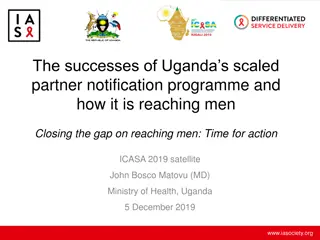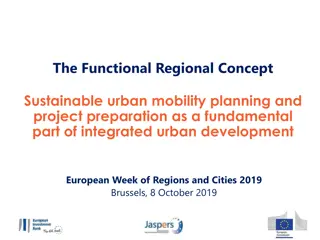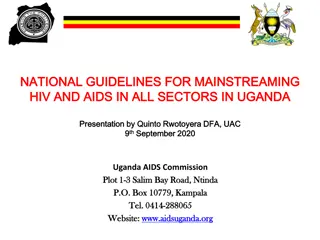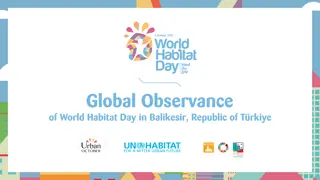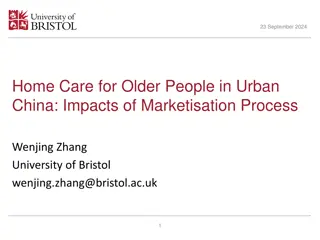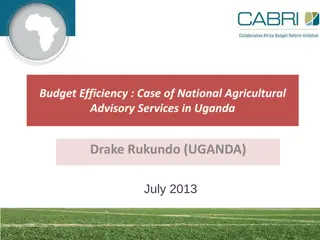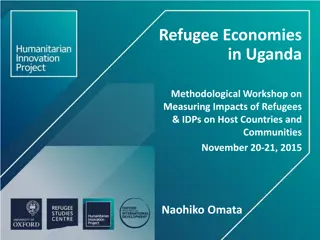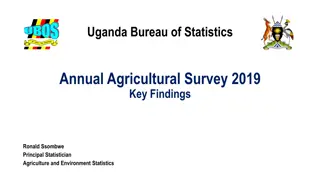The State of the Urban Sector in Uganda - 2022 Report Highlights
The report on the state of the urban sector in Uganda for 2022 outlines the challenges and opportunities arising from rapid urbanization. The goal is to inform policy interventions by identifying development issues, assessing governance strengths and weaknesses, and proposing sector strategies. The scope includes stakeholder engagement in various cities, municipalities, and town councils to analyze and report on Uganda's urban environment.
Download Presentation

Please find below an Image/Link to download the presentation.
The content on the website is provided AS IS for your information and personal use only. It may not be sold, licensed, or shared on other websites without obtaining consent from the author.If you encounter any issues during the download, it is possible that the publisher has removed the file from their server.
You are allowed to download the files provided on this website for personal or commercial use, subject to the condition that they are used lawfully. All files are the property of their respective owners.
The content on the website is provided AS IS for your information and personal use only. It may not be sold, licensed, or shared on other websites without obtaining consent from the author.
E N D
Presentation Transcript
THE STATE OF THE URBAN SECTOR REPORT FOR UGANDA, 2022 FINAL REPORT Presented during the MLHUD Dissemination Workshop
Outline Introduction and background Client s Requirements Methodology Thematic Reports 4/2/2024 GIPEA AFRICA LIMITED 2
Introduction Urban areas are the engines of economic growth & development functioning ( employment, education, technology & knowledge transfer and markets). The primarily challenge of urban development is uncontrolled rapid urbanization (projection: 70% of the world s population will live in cities by 2040). Uganda is also rapidly urbanizing at about 5.2% p.a with 583 TC, 31 MC, 11 Cities. This study was aimed at understanding the current state of urbanization in Uganda so as to inform Policy and other strategic government and private sector interventions. GIPEA AFRICA LIMITED 3
The Goal To produce through a participatory process the state of Urban Development sector report for Uganda 2022. Specific Objectives: Identify the key urban development issues/challenges, potentials/opportunities, and needs and provide information on appropriate implementation Identify institutional and policy strengths and weaknesses in the governance of urban areas and suggest areas for reform Identify and critically analyze the state of urban development Produce a detailed report of the sector strategies for 4/2/2024 4
Scope of work Develop data collection tool (adapted from the UN-HABITAT) Engage stakeholders 11 Cities 10 Municipalities 10Town Councils Analysis the existing situation looking at different thematic areas Write a report on the state of urban environment in Uganda 4/2/2024 GIPEA AFRICA LIMITED 5
Selected urban councils for the study Northern Central Regions Eastern Western Cities Arua Gulu Lira Kitgum Nebbi Kampala Masaka Mbale Jinja Soroti Tororo Iganga Mbarara Hoima Fort Portal Ntungamu Busheny- Ishaka Kira Nansana Municipali ties Kumi Makindye Sssabagabo Luwero Kasangati Kalisizo Mpigi Apac Pader Dokolo Pachwach Buwenge Busiu Nakaloke Pallisa Isingiro Kamwenge Kyenjojo Kihihi Town Councils Aduku Katabi GIPEA AFRICA LIMITED Budaka Kagadi 4/2/2024 6
Approach and Methodology 1 3 2 4 5 Stakeholder engagements Inception Mobilizing team and resources Data collection tool Formulatio n Literature review on the different thematic areas Stakeholder mapping National State of Urban Developme nt report 2022 Data analysis and report writing MDAs TPC of Urban Councils MDF There is limited data on the urban sector in Uganda. Information herein was based on 2014 Census data, some statistics and estimates from sampled ULG Some indicators within the tool could not be handled because of the unavailability of data 4/2/2024 GIPEA AFRICA LIMITED 7
THEMATIC REPORTS 4/2/2024 GIPEA AFRICA LIMITED 8
URBANISATION IN UGANDA 4/2/2024 GIPEA AFRICA LIMITED 9
Overview Uganda has a population base of 35 million and a high population growth rate of 3.2% - one of the fastest- growing populations in Africa (Un-Habitat 2016 2021). Also experiences rapid urban population growth rate - % of the population living in urban areas increased from 12.3% in 2002 to 18.6% in 2014 which reflects an annual urban GR of 5.2% and the level of urbanization Uganda will increase to 50% by 2050 (UBOS 2014). Other Urban Areas 18% Kampala 4% Rural Areas 78% in
THE URBAN SECTOR AS A CATALYST FOR NATIONAL DEVELOPMENT SOCIO- ECONOMIC TRANSFORMATION Government prioritizes sustainable development of the urban sector as the engine for the country s economic growth and to provide high quality of life The sector offers real economic opportunities; about 70% average contribution to the GDP of the Country (NUP). Poverty level is 7% lower in urban areas compared to 19% in rural areas (NUP). If well planned and effectively managed, will result in a competitive and productive sector to stimulate socio- economic growth Benefits of agglomeration which enhances access to services Plays a dual role as a producer and consumer. Market for goods and services both internally generated and from rural areas The target is to attain the Country s Vision 2040 of Middle Income Status if urbanization is harnessed properly 4/2/2024 GIPEA AFRICA LIMITED 11
Urbanization Trends in Uganda Pre-colonial Before 1890, societies in Uganda were organized around tribal kingdoms and it is from these that early urban centres in the country were initiated for administration and public service Kampala Mengo Fort Portal Kabarole Hoima Bunyoro Mbarara Kamukuzi/Ankole, and Bugembe Jinja, Etc End of the 19th century Colonial (1900 1962) Era 1900-1962 was for settlement stabilization, fixation and pseudo-planning by the British and defined Uganda s urban spatial and development pattern Creation of large and medium urban centers as central points of administration, and commerce towards the capital and other world ports. (jinja, Tororo, Mbale) 4/2/2024 GIPEA AFRICA LIMITED 12
Urbanization Trends in Uganda Post-colonial Concentrated and polarized pattern, with the major towns of Kampala and Jinja dominating was consolidated. Medium sized centres functioning as 'intermediary centres and regional headquarters continued to expand Small centers developed more as district administration centres or as administration centres for counties and sub counties; Military State (1970-1980) & 'Changing' Urban Composition Ideology for the military Ugandanization was declared in 1972 that created magendo economy Period of changing urban land uses, environmental decline and growth of the urban informal sector, as well as growing urban poverty Between 1970-1980 - stagnation of the larger centres, the 'stumbling' of some medium centres and the shooting up of smaller centres Creation of administrative provinces which later became main urban centres regime of self-reliance and 4/2/2024 GIPEA AFRICA LIMITED 13
Urbanization Trends in Uganda Period of laissez faire and urban informality (1986 2004) From 1986 2004 - adoption of more liberal economic policies in the pursuit of economic growth after two decades of political turmoil and economic collapse. In the face of central government resource constraints, the changes in internal boundaries and subsequent creation of districts resulted into a gradual evolution of small rural service centres into government recognized urban centres, without any semblance of urbanity. Age of urban renaissance 2005- to-date Urban Policy to control & manage the Country's high urban growth Policy of decentralization; political control of urban areas and the electorate, planning and managing urban areas Supportive policies; National Land Policy, National Land Use Policy, Housing policy, National Environment Management Policy, LED policy, National Population Policy, PPP policy, Slum Upgrading Strategy, etc. Creation of Ministry responsible for Urban Development; Ministry of Local Government - for urban administration and supervision 4/2/2024 GIPEA AFRICA LIMITED 14
Current urbanization trends Population living in urban areas increased from 12.3% in 2002 to 18.6% in 2014 which reflects an annual urban growth rate of 5.2% - among the highest in the world Kampala accounts for 39.6% of the total urban population (2002 Census) however this reduced to 20.3% as the number of urban centres in the country increased proliferation of urban areas By 2035 Uganda s population is projected to 68.4 million of which 30% will be in urban areas Urban Year Rural Total %in urban areas 2002* 2003 2004 2005 2006 2007 2008 2009 2010 2011 2014* 2015 2016 2,999,387 3,091,400 3,247,000 3,410,500 3,582,200 3,762,600 4,372,000 4,524,600 4,692,200 4,859,600 7,425,864 7,759,918 8,109,030 21,442,697 21,998,000 22,612,700 23,330,800 24,047,100 24,818,700 25,220,600 26,136,700 27,092,400 28,080,200 27,208,786 27,883,006 24,442,084 25,089,400 25,859,700 26,741,300 27,629,300 28,581,300 29,592,600 30,661,300 31,784,600 32,939,800 34,634,650 35,648,924 12.3 12.3 12.6 12.8 13 13.2 14.8 14.8 14.8 14.8 21.4 21.8 22.1 4/2/2024 28,586,231 GIPEA AFRICA LIMITED 36,695,261 15
Colonial & post-colonial Urbanization Trends; The country currently has 11 cities 31 Municipalities and 583 Town Councils Urban Centre Populati on as per NUP 1969 1980 1991 2002 2014 2021 No Popn. No. Popn. No. Popn. No. Popn Capital City Cities - 1 1 774,241 1 1,189,142 1 1,507,080 1 1,917,427 at least 300,000 between 50,000 and 299,000 between 10,000 and 50,000 - - 0 0 0 10 1,948,598 Municip alities - 2 13 480,922 13 745,036 33 3,249,609 31 4,134,478 Town Councils - 34 33 338,901 61 1,065,209 163 2,361,033 583 3,003,942 Town Board Total - 4 20 75,589 20 - 62 308,142 - - 41 67 1,669,653 95 2,999,387 259 7,425,864 625 9,447,927
Viability of Ugandas Urban Councils City Criterion for Cities set in NUP 2017 Min. Population Size (300,000 People) Sq.Kms) budget) 1,428,455 195.1 206,115 364.6 93,054 128.3 89,028 228.1 201,371 471.5 108,916 30.1 247,074 215.6 254,915 160.3 308,362 403.1 222,558 387.3 199,602 299.0 Qualifica tion of cities as per the NUP 2017 set criterion Min. Population Density (3,000) Min. Area (100 Functionality (% local revenue to the Appr oved PDP X X X X X X X X X X Built-up area (%) Qualificati on 1 2 3 4 5 6 7 8 9 10 11 Kampala Masaka Fort portal Hoima Mbarara Soroti Jinja Mbale Arua Gulu Lira 7,321.7 565.3 725.3 390.3 427.1 3,618.5 1,146.0 1,590.2 765.0 574.6 667.6 15.6 3.1 6.1 4.7 8.3 5.5 17.0 3.7 51.0 2.6 7.1 76.91 2.53 4.28 3.83 2.93 6.35 9.83 10.87 3.74 4.44 4.44 X X X X X X X X X X Using the urban Policy criteria, all cities in Uganda save Kampala, do not qualify to be cities but upgrading was rather based on administrative arrangement. With NUP set density, only Kampala and Soroti meet the minimum requirement for city status while Masaka, Hoima, Mbarara and Gulu fall way below the threshold Only Kampala and Arua cities meet the minimum requirement under the population threshold while Soroti, Hoima, Fort portal and Lira are far below the threshold. All cities meet the minimum requirement for area however some cities like Masaka, Lira, Gulu, Arua and Mbarara are too big which makes them lose out on other parameters like density. The bigger percentage of these cities, other than Kampala (76.9%), is typically rural (have less than 10% built up coverage except Jinja and Mbale who stand at 10%) which places a big financial burden in service provision to populace that doesn t generate the requisite revenue. All had no approved PDPs except Kampala. Fort Portal, Jinja, Masaka and Hoima cities are in the process of preparing new PDPs while Jinja, Arua and Gulu have their PDPs on deposit. A functional urban council should be able to locally raise at least 50% of its budget but only Arua meets this requirement
Viability of Uganda Urban Councils... Municipa lity Size (80,000 People) Nansana 365,124 1,227.3 Makindye Ssabagabo Kira 317,157 3,288.6 Bushenyi 41,217 456.4 Ntungamo 18,719 367.5 Tororo 42,016 1,359.7 Iganga 55,263 7,675.4 Kumi 36,493 392.4 Kitgum 44,604 1506.9 Nebbi 31,883 589.3 No . Criterion set in NUP 2017 Min. Popn Density (1,600) Sq.Kms) Qualification of Municipalities as per the NUP 2017 set criterion Min.Popn Min. Area (80 Builutp area % Functionality based on local revenue 50%) Appro ved PDP Qualificatio n 1 2 297.5 84.9 6.72 63.2 15.5 9.9 x x 283,272 3,336.5 3 4 5 6 7 8 9 10 96.44 90.3 50.93 30.9 7.2 93.01 29.6 54.1 72.49 1.65 4.44 8.97 72.53 3.03 33.66 1.00 26.4 4.8 2.3 7.8 8.2 5.4 2.8 9.0 x x x x x x x x x The expansion and upgrading of municipalities in Uganda does not follow any systematic criteria but rather selective application which must be corrected. Densities of some municipalities are way above those of cities e.g. Iganga, Kira, Makindye Ssabagabo and Nansana while some are way below the threshold (in Nebbi, Kumi, Ntungamo and Bushenyi. By population criteria, Nansana, Makindye Ssabagabo and Kira would qualify for city status while some would qualify to be TCs. Ntungamo does not even qualify for TC status but rather TB. Based on the minimum area criteria, Iganga MLG would not even qualify for TC status. Only Kira, Bushenyi, Makindye Ssabagabo and Kumi MLGs would qualify to be MLGs using the minimum area criteria. Other than Kumi, all the selected MLGs in the study had approved PDPs. The functionality criterion requires an urban council to be able to locally contribute at least 50% of its budget but none of the MLGs meets this requirement. Ntungamo municipality was the worst performer with only 2.5% locally raised revenue
Viability of Uganda Urban Councils No.Town Council Size (20,000 People) (1,000) 1 Kalisizo 13,981 855.6 2 Kasangati 125,715 1,266.0 3 Kihihi 19,812 397.0 4 Kyenjojo 22,960 238.6 5 Kamwenge 19,286 282.4 6 Busiu 16,632 1,033.0 7 Buwenge 22,126 2,410.2 8 Aduku 7,715 287.9 9 Pakwach 23,040 1,036.9 10 Dokolo 20,135 224.2 Qualific ation Criterion set in NUP 2017 Min. Popn Density Area (20 Sq.Kms) 16.34 99.3 49.9 96.22 68.3 16.1 9.18 26.8 22.22 89.8 Qualificati on of Town Councils as per the NUP 2017 set criterion Min. Popn Min. Built up (%) Functionality based on local revenue 50%) Approve d PDP 6.3 55.4 1.23 1 1.9 2.7 11.8 0.7 1.4 0.7 - No No No No No No No No No No Yes No No No No No No Yes Yes Yes 58.8 11.9 36.5 41.1 36.4 15.3 35.6 19.6 25.4 None of the town councils meets the NUP criteria for TC status. In terms of population size, Kasangati, Kyenjojo, Buwenge, pakwach and Dokolo meet the policy requirements. However, Dokolo TC was the outlier under this criterion. Using the density criteria, Kasangati, Busiu, Buwenge and Pakwach would qualify for TC status but Dokolo, Aduku, Kamwenge, Kyenjojo and Kihihi are outlyers with very low densities Using the minimum area criteria, Kasangati, Kyenjojo, Kamwenge and Dokolo are way above the threshold (above 90 sq kms) which is above the requirement for TC save for Kamwenge. On the other hand, Buwenge was way below the threshold for the minimum area requirement. Using the PDP requirement, Kalisizo, Pakwach and Dokolo would qualify for TC status.
Urban Sector Challenges Mismatch between the policy requirements and the capacity of the urban councils to meet the set requirements Urban growth that is un-planned, with high rates of sprawl and unplanned growth, lack of integration between sectoral and spatial planning, inadequate provision of basic services, weak urban management capacity and significant fiscal constraints Urban youth dependency is large, while the urban working age population remains relatively small hence many urban center now have large numbers of unemployed youth. Urban footprints growing faster than urban population, the physical extent of urban areas in Uganda is growing much faster than their population. This has profound implications for energy consumption, greenhouse gas emissions, climate change and environmental degradation. Climate change: an enduring threat to cities. Urban areas are both the source of the majority of the world s carbon emissions and home to the majority of the country s population that will be the victims of climate change. Shortfall in Funding for Urban Development. Affordable and adequate housing - still an illusion for many; Deteriorating Urban Environment Inadequate Urban Infrastructure and Services 4/2/2024 GIPEA AFRICA LIMITED 20
Government fundamentals for strengthening the urban Sector New Urban Agenda (NUA) and 2030 Agenda for Sustainable Development (SDGs); Vision 2040 identifies fundamentals to harness the opportunities from urbanization; NDP III prioritizes urbanization and urban development as very critical for accelerating socio-economic transformation with the following objectives; NPDP defines the pattern of human settlement; Albertine PDP strategies that are critical to the Uganda's urbanisation process; National Transport Master Plan (2020-2040) strategies that are critical to the Uganda's urbanisation process; Expressway Development Master Plan 2020-2070 strategies for Uganda's urbanisation process; Master Plan on Logistics in the Northern Economic Corridor is focused on implementing a number of strategies that are critical to the Uganda's urbanisation process; National Urban Policy review to bridge the gap between the set standards and the situation on ground. Invest in nation-wide integrated economic and spatial planning. Invest in city-wide development and infrastructure plans. Support urban physical planning and urban systems development 4/2/2024 GIPEA AFRICA LIMITED 21
LAND TENURE 4/2/2024 GIPEA AFRICA LIMITED 22
Land tenure regime in Uganda A well-functioning urban area is contingent upon secure and enforceable rights over land and property Land Act recognizes four classes of land tenure: o Freehold - the holding of registered land in perpetuity or for a period less than perpetuity that may be fixed by a condition o Leasehold - tenure that is created either by contract or by operation of law between two parties , o Mailo - holding of registered land in perpetuity. All its characteristics are exactly the same as freehold tenure. Mainly in Central Uganda and Bunyoro o Customary - predominant mode of access right in Uganda, mainly in eastern and northern regions 4/2/2024 GIPEA AFRICA LIMITED 23
Land tenure regime in Uganda Freehold was most dominant in western region at 34%, mailo in central with 40%, leasehold in central at 23%, customary was highest in eastern with 54% Customary tenure was the most dominant in all regions save central Region Freehold Mailo Lease Custom ary North 32% 0% 19% 48% East 20% 0% 20% 54% West 34% 4% 13% 45% Central 27% 40% 23% 7% Type of Urban Land Tenure Type Customary land tenure was the most dominant in cities (33%), Municipalities (40%) and Town Councils (38%). Free hold was most dominant in TCs at 33% and least dominant at city level (19%). Leasehold was most dominant in cities with 30% coverage Free hold Mail o Leas e Custom ary Cities 19% 14% 30% 33% Municipal ities 25% 15% 14% 40% Town 33% 4% 14% 38% 4/2/2024 Councils GIPEA AFRICA LIMITED 24
Land Tenure Challenges Challenges for planned urban development and management Land Tenure system Mailo Tenure Land The security of occupancy by the lawful and bona fide tenants creates a dual system of property ownership which results in conflicting interests and overlaps in rights on the same piece of land creating land use deadlock between the registered landowners and the tenants resulting into conflicts and, in many cases, evictions. The non-eviction provisions in the law protect the lawful and bona fide tenants from eviction which compounds the complexity of urban planning in Uganda. It is difficult to streamline informal settlements through the regularization of tenure since physical planning is not a ground for compulsory acquisition under Article 26 of the constitution The unplanned, disorganized settlement patterns on mailo land have had a significant effect on the development of an efficient land market in the central region. Households with weaker property rights invest less in housing quality than those with stronger property rights, thereby establishing a causal link between this land tenure system and the development of slums
Land Tenure Challenges Land Tenure system Customary Land Tenure Challenges for planned urban development and management Provides for communal ownership and use of land (person, a family or a traditional institution) in perpetuity. Majority of people may own or have the rights to use land, but they do not have land titles (security of tenure) Obtaining a private certificate of title by individuals is possible but lengthy and cumbersome involving prior agreements with owners such as the community, the clan, and then the respective land boards take up the process of issuing the title. Holder of a certificate of customary ownership may convert his/her holding to freehold (Section 9). However, the option to convert has exacerbated conflicts over land as the elite and speculative purchasers of land especially in the mineral and oil-rich areas have acquired huge pieces of land without the consent of the community in the pretext that it is free land A customary Tenure Registry is non-existent, the process of titling is long and expensive. Customary tenure restricts accessibility to land and therefore affects planning and orderly development. Tenure impedes implementation of PDPs hence the low levels of PDP implementation where this tenure prevails
Government interventions on tenure security Government through MOLHUD has created 21 Regional Land Office (cadaster zonal areas) in order to ease access to land services Development of the Land Information System (LIS) that commenced in 2010 (at Ministry Zonal Offices (MZOs), Surveys Department, the National Land Information Centre and Ministry Headquarters) aimed at establishing an efficient land administration system in Uganda. Central region has nearly all (98.04%) the land registered in comparison to other regions (50%) The Northern region has not had most of its land registered (8%) because of its reliance on the customary system. The complexity of tenure comes into play as over 60% of urban dwellers in Uganda are informal settlers on land (LANDnet Uganda 2017). and Mapping Location of Cadastral sheets that have been fully covered
Strategies for land tenure harmonization & regulation Urban land use planning as a path to land tenure regularization; Tenure Responsive Land Use Planning (TR-LUP) at all stages i.e. planning and implementation. Incorporate tenure responsive LUP with other planning and land management tools and approaches; MoLHUD pilot successes on tenure security through Physical Planning and Systematic Land Adjudication and Certification in the nine (9) Refugee Host Districts (RHDs) since 2019 should be upscaled to other areas. Institutional responsibility and capacity for tenure responsive land-use planning; Enhance capacity and address resource constraints of planning authorities; Improving coordination; Strengthening urban coordination; Local knowledge is key; Avail resources for relocation; and Making urban development and planning a priority. Awareness creation development stakeholders 4/2/2024 GIPEA AFRICA LIMITED 28
SPATIAL PLANNING 4/2/2024 GIPEA AFRICA LIMITED 29
Overview Assessment of this sector was based on PDPs and Detailed plans looking at preparation, implementation and Development Control. The development control function seeks to manage and regulate property development to ensure that all development takes place in conformity with the detailed schemes. In the absence of physical plans, decisions are made entirely at the discretion of the physical planner evaluating a development proposal. This leads to inconsistency in decision making and uncertainty in the minds of developers leading to urban informality.
Availability of PDPs 45% of urban councils had PDPs. Majority of MCs (80%) had PDPs while only 27% of cities had PDPs. PDPs for Gulu, Fort Portal and Jinja were still in draft form. Most cities still used old MC PDPs. 71% of TCs had no PDPs due to meager resources. Central region had the highest share of PDPs at 71% while Western had the lowest with 37%. 100% 80 80% 71 60 60% 48 45 40% 29 27 20 Yes No 20% 0% 80% 71 63 60 57 60% 43 40 38 40% 29 YES NO 20% 0%
Coverage of Detailed Plans Coverage of Detailed Plans Total area coverage under detailed physical plans was very small - only 10%. Urban areas with detailed plans, most did not cover the the entire boundary. 10 8 6 4 urban council 2 0 Cities MC TC Average Absence of detailed plans resulted into growing levels of informality and haphazard growth. Cities and MCs had area coverage of 10% while TCs had 5%. Majority of urban councils save for cities, their level of coverage was between 1 and 30%. TCs - the available detailed plans were mainly work done by students on internship. Cities and MCs had detailed physical plans prepared in the early sixties and no significant effort to review them
Coverage of Detailed Plans Regional Coverage of Detailed Plans 12% 10 10 10% 8% 6 6% 4 4% 2% 0% North East West Central Central region had the least coverage of detailed plans with only 4% followed by the Western region with 6%.Yet, these two regions have the largest percentage of built-up area (hence the informality). Central region with the highest number of urban councils had the least coverage of detailed plans. Central Govt needs to develop a policy or assessment parameters that would drive the preparation and implementation of detailed physical plans in urban areas.
Availability of 5 Year Development Plans 90 78 75 25% 22% 10% CITIES MUNICIPALS TOWN COUNCILS Yes No Majority of urban councils (81%) had 5 year development plans. MCs recorded the highest share with 5 YR Devt Plans at 90%. Cities recorded 78% while TCs had the lowest at 75%. Arua and Gulu cities did not have 5 Yr Devt Plans. Many cities were in the process of developing the said plans. Lack of a 5 Yr devt plans attracts a penalty during the annual performance assessment by OPM hence hinders service delivery.
Availability of 5 Year Development Plans 100 86 80 57 43% 20% 14% 0% NORTH EAST WEST CENTRAL YES NO Western region had the best performance as all urban councils had a 5 Yr devt plans at 100%. Most urban councils in the Northern region lacked the 5 Yr devt plans (43%). The poor performance of 57% was attributed to lack of 5 Yr devt plans by Arua and Gulu and Dokolo TC among others.
Implementation of PDPs and DPS Implementation of PDPs 60% implemented between 0 to 40% of their PDPs. Almost two-thirds of urban councils implemented than 40% of their PDPs. This implies low levels of implementation of PDPs in urban areas. of urban councils 80% 60% less 40% 20% 0% 0 to 40 41 to 70 71 to 100 Majority of MCs at 33% implemented between 11 to 20%. Majority of TCs at 48% implemented between 0 to 10%. Overall, implementation of PDPs in Uganda s urban areas is only at 10%. Most PDPs expired before they were implemented. Low levels of implementation were attributed to; complex land tenure system which makes land acquisition very costly. Inadequate funding and non-prioritization of physical planning activities Weak institutional and enforcement capacity and urban poverty.
Source of Funding for Spatial Planning Source of funding for spatial plans 67 67 63 70 60 50 40 40 37 33 33 40 30 20 20 10 0 0 0 0 West Central North East Local Revenue Central Government Donor Funding Central region use locally raised revenue to fund their PDPs at 67%. North region depended on central government funding at 63%. Eastern region depended on donor funding (67%). Western region depended equally on central government and donor funding both contributing 40% each. Central Government should balance its efforts in other regions for equitable and balanced urban development.
Source of Funding for Spatial Planning Cities depended more on donor funding at 87% than Central Govt funding at only 13% (USMID funded while at MC level). Local revenue was the major source of funding for the MCs at 50% with Central Govt and donor community at 25% each. MCs had more capacity of generating local revenue and were good at prioritization of physical planning. Central Government was the major source of funding for TCs at 67% and local revenue at 33%. Central Govt should prioritize town councils because of their inability to generate adequate local revenue. MCs have demonstrated a good practice of using locally raised revenue in funding PDPs.
Implications The absence of PDPs has resulted into substantial growth of unplanned settlements that lack infrastructure and services. Un-guided concentration in the urban core leading to squatter settlements and dispersion due to sprawl in the urban periphery. Significant urban expansion with developments taking place along major transportation routes, forming ribbon developments and scattered settlements. Lack of access to basic infrastructure and services which are only limited within the CBD and the surrounding areas. Provision of infrastructure and facilities has not matched with the pace of urban growth. Urban development pattern is un-sustainable and renders service provision very costly.
Spatial Planning Challenges Weak governance and institutional framework 10% of TCs had no established PPCs (MoLHUD, 2016). Limited human resources and skills for enforcement of PDPs 25% of TCs had no Physical Planner as Land Officers were in control (MoLHUD, 2016). Limited funding & low prioritization of urban planning 27% of TCs had no budgetary allocation in FY 2013/14 (MoLHUD, 2016). Lack of awareness of available PDPs and roles of each stakeholder 70% of TCs do not carry out sensitization (MoLHUD, 2016). Proposed and existing rights of way, service areas and no development zones are not demarcated for easy enforcement hence encroachment. Poor coordination among planning authorities and infrastructure & utility provision agencies and parastatals. Costly and time consuming processes of preparing PDPs Most Urban Authorities continue to rely on external consultants due to limited capacity and this has a high cost implication. Political interference and competing interests & needs of the political organs of Councils.
Recommendations MoLUD should establish a Physical Planning Fund to support implementation of key and major physical planning proposals in terms of land use and public infrastructure and utilities Expand the coverage of detailed physical plans in urban authorities so as to ensure orderly urban development. Prioritize formulation of urban action area plans for upgrading and promoting vitality of already developed areas. Undertake effective integration of urban physical plans with economic development plans, sector plans and works plans. Provision of public infrastructure and utilities such as road network and public facilities as a strategic tool to lead and induce desired orderly and sustainable developments, (World Bank Report, 2018). Physical demarcation of proposed infrastructural routes, service areas and no- development zones should be undertaken to avoid present and future encroachment. Partner with private real estate developers to pilot innovations in developing planned neighbourhoods or site & serviced areas. Explore and establish sustainable financing options for implementing and enforcing urban physical development plans.
HOUSING 4/2/2024 GIPEA AFRICA LIMITED 42
Overview of Urban Housing The current housing requirement is about 767,000 units, presenting a critical shortage of 54,400 units in Uganda s urban areas. About 70% of the urban population stays in informal settlements, of which 20% reside in typical slums There is a major shortage of decent and affordable rental housing forcing low income population into low quality and squatter settlements in city centers close to jobs. Uganda s urban population will grow from 11 million in 2022 to 20 million in 2035 raising the housing demand to 1.4 million units - a total increase in housing needed of 48,700 units per annum. Housing market is faced with high mortgage interest rates which increase the cost of borrowing leading to high cost of housing.
Urban Housing Demand Year Estimated Population 2014 7,400,000 2022 11,043,000 2035 20,000,000 Number of housing stock required is about 1.4 million units by 2035, of which 285,600 would be required for Kampala alone and 331,800 in Central Region. Additional 633,000 units will have to be build between now and 2035 (about 48,700 units per year). Estimated Housing Demand 514,000 676,000 1,400,000
Urban Housing Demand Urban Household Incomes Issue: Incomes are low and informal for most urban households to afford a house. A household purchasing a low-cost house of Ushs 72 million (US$ 20,000) would need to earn at least Ugx 2,862,011 (US$ 800) a month to afford it, paying a monthly installment of Ugx 1,001,704, represents 35% of the monthly income at an interest rate of 16%. This implies that 89% of the Uganda s urban households could not qualify for mortgage to afford a low-cost house of Ugx 72 million due to low incomes. Household Income 3,321,001 and Above 4 Less than 276,750 2,214,001 3,321,000 7 276,7551 553,500 1,107,001 2,214,000 20 553,501 1,107,000 553,501 1,107,000 31 1,107,001 2,214,000 2,214,001 3,321,000 276,7551 553,500 30 3,321,001 and Above Less than 276,750 8 0 5 10 15 20 25 30 35
Urban Housing Demand Housing Finance Issue: Interest rates are high limiting access to housing finance The interest rate for mortgages ranges from 16 to 20% per annum with a repayment period of up to 20 years. Uganda currently has a total value of Ugx 1.6 billion (US$ 429,166) in residential mortgage loans collectively held by financial institutions. The interest on mortgage loans has still remained relatively high at about 17%. The mortgage market in Uganda accounted for only 1% of the GDP. An urban household with an average monthly income of Ugx 703,000 could afford a mortgage of Ugx 18 million (US$ 5,000) at an interest rate of 16% amortized for 20 years with a monthly repayment of 35% of the monthly income.
Urban Housing Demand Urban Rental Housing Issue: Rental housing is more affordable and accessible though of low quality. Rental housing is growing at a higher rate due to un- affordability of own house ownership. 48% of urban households were renting. The average household monthly rent is Ugx 263,500 ($74) for both formal and informal rentals. For an urban household earning the average monthly income of Ugx 703,000, this amounts to 37.5% of monthly expenditure on house rent, above the maximum 30% expenditure standard. Hence, most urban households staying in rented housing were facing un-affordable house rents.
Urban Housing Demand Monthly House Rent 321,200 46 Urban Councils Share Spent on Rent (%) Status Cities Struggling Municipals 284,700 40 Struggling Town C 184,900 26 Affordable Region Level North 205,730 29 Affordable East 247,400 35 Struggling West 322,920 46 Struggling Central 351,560 50 Severely Cost- Burdened
Supply of Urban Housing Main Issue: Poor Conditions & Inadequate Formal Supply of Housing. Quality of Urban Housing Issue: About 70% of urban households live in informal settlements, of which 20% stay in typical slums There is still shortage of decent and affordable rental dwellings which doesn t match with urban population growth. Growing conversion of owner-occupied houses into rental accommodation increases the share of rental housing.
Supply of Urban Housing 90 60 80 50 70 40 60 City Municipalities Town councils 30 Owner occupier 50 Rented 40 20 Social housing 30 10 20 0 10 Owner occupier Rented Social housing 0 North East West Central Cities had about 50% of households renting, followed by town councils and municipals at 47.5% and 41 respectively. Kampala had the highest percentage of renting households at 72%. Municipalities and town councils had a high demand for land for construction of individual dwellings (owner-occupiers) resulting in low-density areas. Central region had the highest share of renting households with 46% due to high concentration of Uganda s urban population
